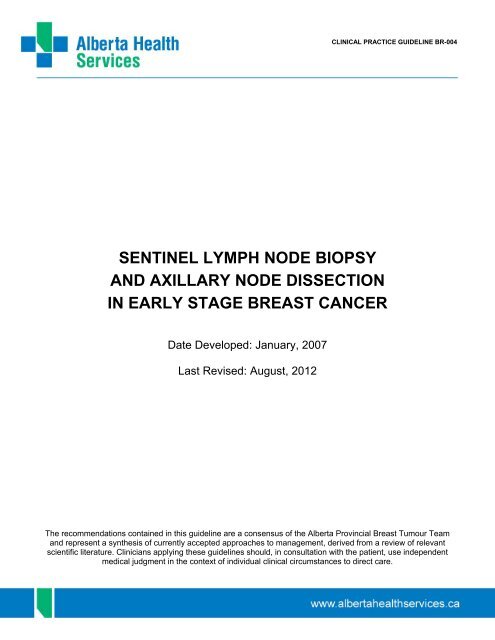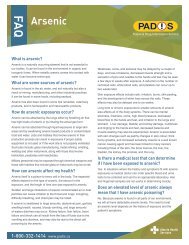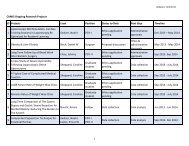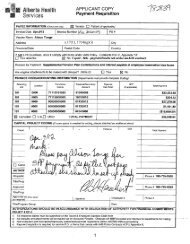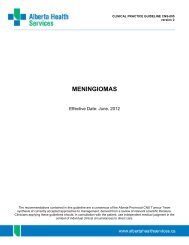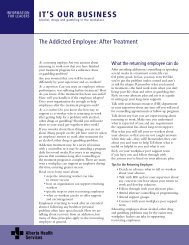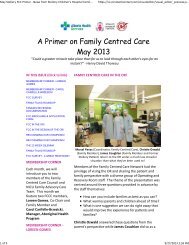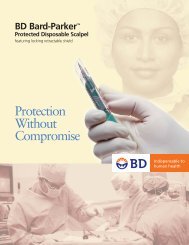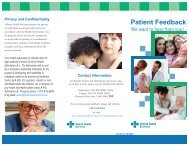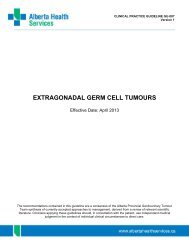Sentinel Lymph Node Biopsy and - Alberta Health Services
Sentinel Lymph Node Biopsy and - Alberta Health Services
Sentinel Lymph Node Biopsy and - Alberta Health Services
Create successful ePaper yourself
Turn your PDF publications into a flip-book with our unique Google optimized e-Paper software.
SENTINEL LYMPH NODE BIOPSY<br />
AND AXILLARY NODE DISSECTION<br />
IN EARLY STAGE BREAST CANCER<br />
Date Developed: January, 2007<br />
Last Revised: August, 2012<br />
CLINICAL PRACTICE GUIDELINE BR-004<br />
The recommendations contained in this guideline are a consensus of the <strong>Alberta</strong> Provincial Breast Tumour Team<br />
<strong>and</strong> represent a synthesis of currently accepted approaches to management, derived from a review of relevant<br />
scientific literature. Clinicians applying these guidelines should, in consultation with the patient, use independent<br />
medical judgment in the context of individual clinical circumstances to direct care.
BACKGROUND<br />
CLINICAL PRACTICE GUIDELINE BR-004<br />
Axillary lymph node status is an important indicator of prognosis in patients with breast cancer. 1<br />
Knowledge of lymph node status also guides adjuvant therapy decision-making, thereby improving<br />
regional <strong>and</strong> distant control in patients with node-positive disease. Physical examination <strong>and</strong>/or imaging<br />
underestimate the presence of axillary lymph nodal involvement in 20 to 30% of patients with clinically<br />
negative axillae. 2 Known risk factors for axillary involvement have some predictive value but are not as<br />
reliable at predicting node status as surgery <strong>and</strong> pathological examination of the tissue. Therefore, the<br />
treatment of patients with invasive breast cancer has routinely included axillary lymph node dissection<br />
(ALND). ALND however, is associated with significant morbidity, including arm lymphedema, pain, <strong>and</strong><br />
decreased quality of life 3-5<br />
<strong>Sentinel</strong> lymph node biopsy (SLNB) in early stage breast cancer using radioisotope was described by Alex<br />
<strong>and</strong> Krag in 1993, 6 providing an accurate, less invasive method of axillary staging <strong>and</strong> the ability to<br />
identify women with no nodal disease in whom ALND could be avoided. In addition, SLNB has been<br />
shown to stage axillary nodes more accurately 7,8 with reduced postoperative <strong>and</strong> long term morbidity. 9-11<br />
The role of SLNB in treatment of patients with invasive breast cancer has evolved over time, pending<br />
results from pivotal clinical trials <strong>and</strong> studies evaluating special circumstances.<br />
The purpose of this guideline is to establish a st<strong>and</strong>ard of care in <strong>Alberta</strong> for patients with early-stage<br />
breast cancer, with respect to the management of the axillary nodes. This guideline will address the<br />
indications for sentinel lymph node biopsy, management of patients with a positive finding, <strong>and</strong><br />
considerations for implementing this procedure in an institution.<br />
GUIDELINE QUESTIONS<br />
The questions below were based on established guideline frameworks for this topic. In 2005, the American<br />
Society of Clinical Oncology developed recommendations for the use of sentinel lymph node biopsy in<br />
early-stage breast cancer, which addressed the value of SLNB in practice, appropriate patient selection,<br />
technical considerations, <strong>and</strong> risks <strong>and</strong> benefits of the procedure. 12 Then in 2009, Cancer Care Ontario<br />
(CCO) developed recommendations to address these same issues, plus organizational/ operational<br />
considerations <strong>and</strong> the management of patients with a positive SLNB. 13 The questions below address all<br />
of these aspects of SLNB, within the context of <strong>Alberta</strong>.<br />
1. Should SLNB be recommended as st<strong>and</strong>ard of care for patients with early-stage breast cancer?<br />
2. What is the role of SLNB in special situations in clinical practice? (i.e. large <strong>and</strong> locally advanced<br />
invasive tumours, multicentric tumours, inflammatory breast cancer, ductal carcinoma in situ (DCIS),<br />
older age (65 years or more), obesity, male breast cancer, pregnancy, evaluation of the internal<br />
mammary nodes, presence of suspicious palpable axillary nodes, prior breast or axillary surgery, <strong>and</strong><br />
preoperative systemic therapy?<br />
3. Which patients should undergo ALND? Can ALND be avoided in patients with negative findings on<br />
SLNB? Is ALND necessary for all patients with positive findings on SLNB? Which patients should be<br />
referred for multidisciplinary referral <strong>and</strong> discussion?<br />
4. What are the benefits <strong>and</strong> risks associated with SLNB? How can risks (i.e. complications <strong>and</strong> falsenegative<br />
results) be minimized (e.g. surgeon experience, institution criteria, etc.)?<br />
Page 2 of 16
CLINICAL PRACTICE GUIDELINE BR-004<br />
5. What are the recommended surgeon experience/training <strong>and</strong> organizational criteria <strong>and</strong> resources for<br />
performing SLNB?<br />
6. How should SLNB be performed (i.e. what are the appropriate mapping technique, operative<br />
technique, <strong>and</strong> histological technique)?<br />
DEVELOPMENT PANEL<br />
This guideline was reviewed <strong>and</strong> endorsed by the <strong>Alberta</strong> Provincial Breast Tumour Team. Members of<br />
the <strong>Alberta</strong> Provincial Breast Tumour Team include breast surgeons, medical oncologists, radiation<br />
oncologists, nurses, pathologists, <strong>and</strong> pharmacists. Evidence was selected <strong>and</strong> reviewed by a working<br />
group comprised of members from the <strong>Alberta</strong> Provincial Breast Tumour Team <strong>and</strong> a Knowledge<br />
Management Specialist from the Guideline Utilization Resource Unit. A detailed description of the<br />
methodology followed during the guideline development process can be found in the Guideline Utilization<br />
Resource Unit H<strong>and</strong>book.<br />
SEARCH STRATEGY<br />
The MEDLINE, Cochrane, <strong>and</strong> CANCERLIT databases, as well as ASCO abstracts <strong>and</strong> proceedings were<br />
searched for literature relevant to these topics. The search included practice guidelines, systematic<br />
reviews, meta-analyses, r<strong>and</strong>omized controlled trials, <strong>and</strong> clinical trials.<br />
Literature published between 1950 <strong>and</strong> March 2011, comparing sentinel lymph node biopsy with axillary<br />
lymph node dissection, was collected using the following search terms: “sentinel lymph node biopsy” AND<br />
“lymph node dissection” OR “axillary node dissection” AND “breast cancer.” Literature published between<br />
1950 <strong>and</strong> March, 2011, pertaining to axillary lymph node dissection in sentinel node positive breast cancer<br />
patients, was collected using the following search terms: “lymphadenectomy” OR “sentinel lymph node<br />
biopsy” OR “axillary lymph node dissection” <strong>and</strong> “breast cancer.”<br />
A total of five practice guidelines <strong>and</strong> seven r<strong>and</strong>omized controlled trials were identified. In addition,<br />
several other prospective cohort studies (e.g. non-controlled clinical trials) were also considered as<br />
evidence.<br />
Following a review of several existing guidelines on this topic, the <strong>Alberta</strong> Provincial Breast Tumour<br />
Team’s SLNB guideline working group agreed to adapt the Cancer Care Ontario (CCO, 2009) guideline on<br />
SLNB in early-stage breast cancer. 12,13 The CCO (2009) recommendations were updated for use in<br />
<strong>Alberta</strong>, following an update of the evidence on this topic, from the MEDLINE <strong>and</strong> EMBASE databases<br />
(May 2008 to March 2011).<br />
TARGET POPULATION<br />
The target population for this guideline is patients with newly diagnosed, early-stage breast cancer.<br />
Page 3 of 16
RECOMMENDATIONS<br />
CLINICAL PRACTICE GUIDELINE BR-004<br />
1. Axillary Staging. SLNB is recommended for axillary staging of all patients with clinically node negative<br />
early-stage breast cancer. Patients with pre-operative biopsy proven nodal metastases should undergo<br />
axillary lymph node dissection upfront.<br />
2. Special Clinical Scenarios. Described below are three clinical situations: those in which there is a<br />
clear role for SLNB, those in which SLNB is not recommended, <strong>and</strong> those in which the role of SLNB is<br />
unclear (see Table 1 also).<br />
There is sufficient evidence to support the use of SLNB in patients with T1-2 tumours, multicentric<br />
tumours, DCIS (with mastectomy), older age, obesity, <strong>and</strong> bilateral breast cancer. Clinicians <strong>and</strong><br />
patients should note that older age <strong>and</strong>/or obesity are risk factors for failed SLN mapping.<br />
SLNB is not recommended for patients with inflammatory T4 breast cancer, clinically positive nodes,<br />
or prior axillary surgery.<br />
o For clinically suspicious nodes, preoperative needle biopsy (FNA or core) can be performed;<br />
patients with a biopsy confirming metastatic disease should proceed directly to ALND.<br />
The role of SLNB is less clear in the following circumstances: internal mammary lymph nodes,<br />
before preoperative systemic therapy, T3 or T4 tumours, DCIS (without mastectomy), suspicious<br />
palpable axillary nodes, after preoperative systemic therapy, prior diagnostic or excisional breast<br />
surgery, prior non-oncologic breast surgery, <strong>and</strong> pregnancy. For pregnant patients, there are<br />
concerns about the safety of blue dye; decisions should be made on a case by case basis.<br />
Table 1. Role of sentinel lymph node biopsy in special clinical scenarios (Adapted * from: ASCO, 2005). 12<br />
Clinical Circumstance<br />
Guidance Evidence †<br />
T1 or T2 tumors Acceptable Good<br />
T3 or T4 tumors Acceptable Limited 14,15<br />
Multicentric tumors Acceptable Limited<br />
Inflammatory breast cancer Not recommended Insufficient<br />
Ductal carcinoma in situ with Acceptable Limited<br />
mastectomy<br />
Ductal carcinoma in situ without<br />
mastectomy<br />
Not recommended; unless<br />
microinvasion is<br />
suspected or proven<br />
Limited 16,17<br />
Suspicious, palpable axillary nodes Not recommended Good<br />
Older age Acceptable Limited<br />
Obesity Acceptable Limited<br />
Male breast cancer Acceptable Limited<br />
Pregnancy Acceptable Limited 18,19<br />
Evaluation of internal mammary lymph Acceptable<br />
nodes<br />
Limited 20,21<br />
Prior diagnostic or excisional breast<br />
biopsy<br />
Acceptable Limited 22<br />
Prior axillary surgery Not recommended Limited 23<br />
Prior non-oncologic breast surgery<br />
(augmentation, reduction,<br />
reconstruction)<br />
Not recommended; unless location of<br />
incision allows for non-disruption of<br />
lymphatic system<br />
Insufficient<br />
After preoperative systemic therapy Acceptable Limited 24-27<br />
Before preoperative systemic therapy Acceptable Limited<br />
*Modifications to the ASCO (2005) table are italicized; new evidence is cited, where applicable.<br />
Page 4 of 16
CLINICAL PRACTICE GUIDELINE BR-004<br />
† Good evidence: multiple studies of SLNB test performance based on findings on completion axillary lymph node dissection<br />
Limited evidence: few studies of SLNB test performance based on findings on completion axillary lymph node dissection. or<br />
multiple studies of mapping success without test performance assessed.<br />
Insufficient evidence: no studies of SLNB test performance based on findings on completion axillary lymph node dissection <strong>and</strong><br />
few if any studies of mapping success.<br />
3. Role of Additional Surgery. Described below are the circumstances in which ALND is recommended,<br />
circumstances in which ALND may not be recommended, <strong>and</strong> circumstances in which ALND is not<br />
recommended (see Table 2 also).<br />
ANLD is recommended in:<br />
o Patients with positive results from a pre operative needle biopsy of clinically suspicious nodes.<br />
o All patients with positive findings on SLNB according to routine histopathologic examination<br />
▪ Data from a meta-analysis of 1842 patients demonstrates that among patients with a<br />
positive SLN, 48.3% were found to have additional node disease on ALND. 12,28<br />
▪ Metastasis is found in nonsentinel nodes in approximately 10% of patients with isolated<br />
tumor cells in the SLN <strong>and</strong> in 20 to 35% of patients with micrometastases in the SLN. 12,29<br />
▪ Patients in whom there was a failed attempt to localize a sentinel node.<br />
ALND may not be recommended in:<br />
o Patients with life-shortening co-morbidities.<br />
o Patients with high perioperative risk.<br />
o Recent data from the Z0011 trial (2011) supports omission of ALND in a select group of<br />
patients with two or fewer positive nodes who are treated with breast conserving surgery<br />
(clinical T1-2 N0 M0 treated with whole breast irradiation <strong>and</strong> adjuvant systemic therapy). 30<br />
o A decision to omit ALND should be made on a case by case basis with multidisciplinary input,<br />
ideally in a tumour board setting, if available.<br />
ALND is not recommended: in patients with negative findings on SLNB.<br />
Please refer to Appendix 1 for the <strong>Alberta</strong> Provincial Breast Tumour Team’s consensus-based<br />
guidelines for multidisciplinary referral <strong>and</strong> discussion in node positive patients.<br />
Table 2. Role of ALND in special clinical scenarios.<br />
Clinical Circumstance<br />
Guidance<br />
Positive results from a pre operative needle biopsy of<br />
clinically suspicious nodes<br />
Recommended<br />
Positive findings on SLNB according to routine<br />
histopathologic examination<br />
Recommended<br />
Failed attempt to localize a sentinel node Recommended<br />
Life-shortening co-morbidities May not be recommended<br />
High perioperative risk May not be recommended<br />
Low risk of residual axillary disease; select patients May not be recommended<br />
Negative findings on SLNB Not recommended<br />
4. Technical Considerations. <strong>Sentinel</strong> lymph node mapping <strong>and</strong> localization has been shown to be<br />
highest using the periareolar dual injection technique with radioisotope <strong>and</strong> vital blue dye. Pathologic<br />
evaluation of excised sentinel lymph nodes should evaluated with cut sections no thicker than 2.0 mm.<br />
The identification of the SLNs should be guided by h<strong>and</strong> held gamma probe readings, allowing the<br />
surgeon to identify the sentinel node/s with the probe.<br />
o The 10% rule may be employed to identify SLNs (i.e., all nodes with a count greater than 10%<br />
of the hottest count is considered a SLN) as well as visual inspection for blue-stained nodes.<br />
Page 5 of 16
CLINICAL PRACTICE GUIDELINE BR-004<br />
o Removal of no more than four SLNs has been associated with low false negative rates; minimal<br />
additional information is provided from five or more nodes <strong>and</strong> the risk of additional morbidity is<br />
greater.<br />
o The surgeon should palpate for clinically suspicious nodes which are considered to be SLNs.<br />
With the use of the radioisotope, it is also possible to demonstrate that radioactive nodes have been<br />
removed by performing ex vivo counts on the resected tissue.<br />
The use of serial sections no thicker than 2.0 mm allows for the recognition of small metastatic<br />
deposits that might be missed by the examination of a lymph node that has been bivalved;<br />
Hematoxylin & Eosin staining is routinely employed. The use of IHC evaluation should not be used<br />
routinely. 30,31<br />
5. Risks <strong>and</strong> Benefits of <strong>Sentinel</strong> <strong>Lymph</strong> <strong>Node</strong> <strong>Biopsy</strong>. The following risks <strong>and</strong> benefits have been<br />
associated with the use of sentinel lymph node biopsy (SLNB):<br />
SLNB is associated with reduced morbidity with equivalent positive node detection rates, compared<br />
with ALND, as it is a less invasive surgery (outpatient procedure <strong>and</strong> no need for drains), has fewer<br />
complications (e.g., sensory changes, lymphedema), <strong>and</strong> has enhanced pathologic staging.<br />
Possible allergic reactions to blue dye represent a potential harm. Skin necrosis has been<br />
associated with methylene blue use.<br />
Physicians should demonstrate caution regarding false-negative results; success of the procedure<br />
(i.e. low false-negative rates) is determined by several quality indicators, including team experience,<br />
case volume, <strong>and</strong> adherence to established protocols in nuclear medicine, pathology, <strong>and</strong> surgery.<br />
6. Operational Considerations. SLNB should be performed by an experienced team to ensure that<br />
results are equivalent to those obtained with ALND.<br />
The proportion of patients successfully mapped correlates with false-negative rates <strong>and</strong> is a<br />
reasonable indicator of quality; consistent pathology <strong>and</strong> nuclear medicine protocols need to be<br />
adhered to.<br />
The recommended surgeon training includes completion of at least one of the following:<br />
o training during a residency or fellowship program<br />
o mentorship with an experienced surgeon (may include a formal didactic course)<br />
o combining the procedure with a number of completion dissections to demonstrate acceptable<br />
accuracy (may include a formal didactic course)<br />
The minimum system recommendations are that clinicians <strong>and</strong> patients should have access to:<br />
o a licensed nuclear medicine facility that follows a defined SLNB protocol to perform injection by<br />
nuclear medicine personnel or the surgeon<br />
o a surgeon with appropriate training <strong>and</strong> experience in sentinel node detection <strong>and</strong> extraction<br />
<strong>and</strong> access to a h<strong>and</strong>-held gamma probe, which is used to detect the SLN<br />
o a pathologist who assesses the SLN specimens according to a st<strong>and</strong>ardized protocol<br />
DISCUSSION<br />
Indications for sentinel lymph node biopsy<br />
Axillary staging. Four r<strong>and</strong>omized controlled trials have reported high sentinel lymph node (SLN)<br />
detection rates (95 to 97%) 31-33 <strong>and</strong> accuracy rates (94 to 98%) 34 with low false-negative rates<br />
(9.5%), 31 especially with training <strong>and</strong> the use of blue dye in addition to radioisotope (6.7%). 34 The<br />
most controversial of reasons to continue axillary dissection is whether it has a survival benefit.<br />
Among patients who underwent sentinel lymph node biopsy (SLNB) <strong>and</strong> axillary lymph node<br />
Page 6 of 16
CLINICAL PRACTICE GUIDELINE BR-004<br />
dissection (ALND) versus those who underwent SLNB alone, disease-free <strong>and</strong> overall survival rates<br />
were similar (95.0-95.5% vs. 94.8-96.4% <strong>and</strong> 88.6-89.9 vs. 87.6-89.0%, respectively). 31-33 Orr (1999)<br />
conducted a systematic review of all trials in which patients were r<strong>and</strong>omized to either st<strong>and</strong>ard<br />
treatment in the axillae versus no axillary treatment. 35 Each individual trial showed a non-significant<br />
survival improvement favoring ALND. When trial results were combined there was a statistically<br />
significant, 5%, overall survival advantage with ALND. However, the generalizability of these results to<br />
the present has been questioned because the trials were carried out many years ago <strong>and</strong> included<br />
predominantly node-positive patients with large (palpable) primary tumours <strong>and</strong> without modern<br />
systemic therapies. 36 Overall, several national guidelines support the use of SLNB as a preferred<br />
method of axillary staging or st<strong>and</strong>ard of care in patients with node-negative, early-stage breast<br />
cancer. 13,37-39<br />
Special clinical scenarios. The use of SLNB in patients with T1 or T2 tumours, multicentric tumours,<br />
DCIS (with mastectomy), older age, obesity, <strong>and</strong> bilateral breast cancer is supported by the CCO, 2009<br />
guideline 13 <strong>and</strong> the National Comprehensive Cancer Network (NCCN), 2010 guideline. 37 The<br />
recommendation against performing routine SLNB in patients with inflammatory T4 breast cancer or those<br />
with prior axillary surgery, was based on the CCO, 2009 guideline <strong>and</strong> the exclusion criteria of several<br />
RCTs. 31-34,40-42 It should be noted, however, that patients with a minor previous axillary surgery could be<br />
considered for SLNB on an individual basis. 13 As data are limited, the role of SLNB is unclear in the<br />
following circumstances: internal mammary lymph nodes, before preoperative therapy, T3 or T4 tumours,<br />
DCIS (without mastectomy), suspicious palpable axillary nodes, after preoperative systemic therapy, prior<br />
diagnostic or excisional breast surgery, prior non-oncologic breast surgery, <strong>and</strong> pregnancy. 13<br />
For patients with prior non-oncologic surgery, limited data exists due to exclusion of such patients from<br />
large series. Case by case evaluation is required to determine if disruption of the lymphatics may be<br />
expected, based on prior incisions <strong>and</strong> on the duration of time since the non-oncologic surgery. Routine<br />
use of pre-operative lymphoscintigraphy may be of benefit in this population to confirm that mapping is<br />
successful.<br />
For patients with DCIS having breast conserving surgery, use of sentinel lymph node biopsy should not be<br />
performed routinely. 12 Performance of SLNB should be determined on a case by case basis with<br />
consideration given to the likelihood of occult invasive disease based on characteristics of the DCIS (e.g.,<br />
size >5 cm, discordant radiology suggestive of invasion, palpable lesion, possible microinvasion on core<br />
biopsy, etc.) <strong>and</strong> the possibility of performing an accurate SLNB after breast conserving surgery.<br />
For pregnant patients, there exist concerns about the safety of blue dye. Several RCTs excluded pregnant<br />
patients. 14,32-34 However, radiation exposure to the fetus using non-iodine radioisotopes in the dosages<br />
used for the sentinel node technique appear to be minimal. 18,19 The CCO (2009) guideline states that<br />
most members of their Expert Panel would use the SLNB technique in a pregnant woman beyond the 1 st<br />
trimester, weighing risk versus benefit on a case-by-case basis. 13<br />
For patients with clinically positive nodes, SLNB is contraindicated, as it has been suggested that the path<br />
of the dye or the radio-colloid agent may be blocked from tumour cells infiltrating the lymph vessels, which<br />
could prevent the identification of the true sentinel node(s) <strong>and</strong> result in failure of the procedure or false<br />
negative results. 43 In these cases, a preoperative needle biopsy can be performed, followed by an ALND<br />
in those with confirmed metastatic disease.<br />
Page 7 of 16
Management of patients following sentinel lymph node biopsy<br />
CLINICAL PRACTICE GUIDELINE BR-004<br />
Role of additional surgery for patients with a positive SLN. The current st<strong>and</strong>ard of practice is to<br />
perform ALND following a positive SLNB. 12,13,37-39 A recent study by Guiliano, et al. 2011 30 (ACOSOG<br />
Z0011 trial) suggests that ALND may not be necessary in a select group of sentinel lymph node (SLN)<br />
positive patients. The data showed that among 891 SLN positive patients undergoing breast conserving<br />
surgery, tangential whole breast radiotherapy <strong>and</strong> systemic chemotherapy with or without hormonal<br />
therapy, who were r<strong>and</strong>omized to either SLNB alone or SLNB plus ALND, the regional <strong>and</strong> axillary<br />
recurrence rates were found to be 0.5 <strong>and</strong> 0.9%, respectively. Furthermore, five-year in-breast recurrence<br />
<strong>and</strong> disease-free survival rates were not significantly different (2.1 vs. 3.7%, respectively, p=0.16; <strong>and</strong><br />
83.8 vs. 82.2%, respectively, p=0.13) after a median follow-up of 74.4 months.<br />
Retrospective studies among patients who received false-negative SLNB results, <strong>and</strong> therefore did not<br />
undergo ALND, have largely shown no differences in recurrence or survival rates. 44-47 However, given that<br />
the strength of evidence from retrospective studies is low by nature, caution is warranted in the<br />
interpretation of these results. Furthermore, the MIRROR study 41 showed that, among node-positive<br />
patients with isolated tumour cells (ITC) or micrometastases, the adjusted risk for disease events was 43%<br />
lower (95% confidence interval, 0.45 to 0.73) for those who received systemic adjuvant therapy (n=856)<br />
versus those who did not (n=995), with a median follow-up of 5.1 years. Until data from more r<strong>and</strong>omized<br />
controlled trials becomes available, the evidence for changing current practice in favor of omitting ALND<br />
routinely, following a positive SLNB, is not sufficient. 12,13 One RCT evaluating a highly selected cohort of<br />
low risk but node positive patients (age >50, no LVI, T1 & T2 tumours) treated with SLNB alone, BCS,<br />
whole breast radiotherapy <strong>and</strong> systemic therapy found no difference in axillary recurrence or overall<br />
survival at 6.3 years follow up.<br />
Role of additional surgery for patients with a negative SLN. Axillary lymph node dissection is not<br />
recommended in patients with negative findings on SLNB. This is supported by several clinical practice<br />
guidelines, 12,13,21,23 based on the results of several RCTs among clinically node negative patients that<br />
showed no survival (overall or recurrence-free) differences among patients who underwent SLNB alone<br />
<strong>and</strong> those who underwent SLNB plus ALND. 31-33,48,49<br />
Technical <strong>and</strong> practical considerations for sentinel lymph node biopsy<br />
Benefits <strong>and</strong> risks of sentinel lymph node biopsy. The major attraction of SLNB over ALND for axillary<br />
assessment is that it has less morbidity in terms of patient discomfort <strong>and</strong> lymphedema. 14,50-62 Data from<br />
r<strong>and</strong>omized trials have confirmed that patients treated with SLNB alone had significantly less arm <strong>and</strong><br />
axillary pain, improved range of motion, less lymphedema, less numbness, fewer complications, <strong>and</strong><br />
better short term quality of life than those treated with ALND. 14,31-35,54,62,63 Furthermore, SLNB allows the<br />
nodes to be examined more closely, thereby accurately predicting the status of the axilla by identifying the<br />
first lymph node(s) receiving lymphatic drainage from the breast tumor. Today it is widely used as a single<br />
staging method. 64 The major concern with SLNB is that it can underestimate the presence of nodal<br />
metastases <strong>and</strong> thus lead to incorrect prognostic information, suboptimal treatment, <strong>and</strong> potentially a<br />
survival disadvantage. However, false-negative rates associated with SLNB have been declining <strong>and</strong> are<br />
now reported at between 3 to 14%. 54,65<br />
In a general breast cancer population with clinically negative axilla, the node positive rate is 30%; thus,<br />
given a SLNB false negative rate of 10%, about 3 per 100 women will be misinformed that they have<br />
negative axillary nodes, 56 which may be similar to false negative rates of formal axillary node dissections.<br />
Recent studies have demonstrated that, at follow-up periods of up to eight years, overall survival <strong>and</strong><br />
disease-free survival are high (90.3 to 94.8% overall survival <strong>and</strong> 81.5 to 87.6% disease-free survival) 30-32<br />
Page 8 of 16
CLINICAL PRACTICE GUIDELINE BR-004<br />
for SLNB <strong>and</strong> not significantly different than ALND. 30-32,48 Physicians should demonstrate caution<br />
regarding false-negative results; as discussed in greater detail below, low false-negative rates are better<br />
achieved when the team is experienced in the SLNB procedure.<br />
Technical considerations. <strong>Sentinel</strong> lymph node detection rates are negatively impacted by minimal<br />
surgeon training. 13,66-68 Surgeon experience is mentioned as a quality indicator in several guidelines<br />
including CCO (2009), 13 NCCN (2010) 37 <strong>and</strong> NICE (2009). 39 The ASCO (2005) guideline, 12 on which the<br />
CCO (2009) guideline was based, recommends that surgeons take a formal course on the technique, with<br />
didactic <strong>and</strong> h<strong>and</strong>s-on training components; have an experienced mentor; keep track of individual results,<br />
including the proportion of successful mappings, false-negative rates, <strong>and</strong> complication rates; <strong>and</strong><br />
maintain follow-up on all patients over time. Other factors that have been shown to negatively impact the<br />
success of SLNB include high body mass index 34,67 <strong>and</strong> multicentric tumours (versus unifocal). 34,69<br />
Factors for which evidence was unclear included tumour location, tumour grade/size, number of sentinel<br />
nodes harvested, <strong>and</strong> non-visualization of sentinel nodes on pre-operative lymphoscintigraphy.<br />
The removal of more than one node is associated with a lower false-negative rate among patients with<br />
biopsy-proven clinical stage T1-2, N0 breast cancers; 70 however, the removal of more than four nodes is<br />
not recommended. Martin, et al. (2001) demonstrated, among a cohort of 94 patients with the hottest<br />
SLN benign, that the false-negative rate drops to 8% at the fourth or greater SLN site. 71 Yet, among a<br />
cohort of 1358 patients, the false-negative rate did not improve significantly with the removal of additional<br />
nodes (i.e. 9.4% for four nodes, 8.8% for five nodes, <strong>and</strong> 7.7% for more than five nodes). 72 Given the<br />
potential morbidity associated with the removal of additional nodes <strong>and</strong> lack of additional benefit, the<br />
removal of more than four nodes is not cost-effective <strong>and</strong> cannot be recommended.<br />
The dual injection (radiocolloid <strong>and</strong> blue dye) technique was endorsed in several guidelines, including<br />
CCO (2009) 13 NICE (2009) 39 <strong>and</strong> ASCO (2005) 12 based on its use in some RCT protocols. 15,48,73 Other<br />
RCTs allowed use of either radiocolloid or dye or both. 30,31,33,34 Operative technique varied slightly among<br />
RCTs; pathologic evaluation included the use of serial sectioning of specimens, but varied in terms of<br />
intervals between sections, number of levels sectioned, <strong>and</strong> thickness of sections. The CCO (2009)<br />
guideline recommends that excised sentinel lymph nodes are sectioned no thicker than 2 mm parallel to<br />
the longest meridian, to allow for the recognition of small metastatic deposits that might be missed by the<br />
examination of a lymph node that has been bivalved. 13 Hematoxylin <strong>and</strong> Eosin is routinely used to<br />
examine tissue sections for SLN micrometastases; however, a role for immunohistochemistry staining in<br />
this setting has not been established. 30,31<br />
Operational considerations. SLNB should be performed by an experienced, multidisciplinary team to<br />
ensure results (e.g. false negative rates) are equivalent to those obtained with ALND. 13,74,75 As outlined in<br />
the CCO (2009) guideline, clinicians <strong>and</strong> patients should have access, at minimum, to a licensed nuclear<br />
medicine facility that follows a defined SLNB protocol to perform the injection, a surgeon with appropriate<br />
training <strong>and</strong> experience in sentinel node detection <strong>and</strong> extraction; access to a h<strong>and</strong>-held gamma probe,<br />
which is used to detect the SLN, <strong>and</strong> a pathologist who assesses the SLN specimens according to a<br />
st<strong>and</strong>ardized protocol. 13 These institutional requirements were addressed only by the CCO (2009)<br />
guideline <strong>and</strong> are relevant in the <strong>Alberta</strong> environment. However, several guidelines described a<br />
multidisciplinary team, which should consist of a surgeon, a nuclear physician (where nuclear medicine<br />
facilities are available), a pathologist, an anesthetist, <strong>and</strong> specialist nurses. 12,13,75<br />
Page 9 of 16
GLOSSARY OF ABBREVIATIONS<br />
Acronym Description<br />
ALND axillary lymph node dissection<br />
ASCO American Society of Clinical Oncology<br />
CCO Cancer Care Ontario<br />
DCIS ductal carcinoma in situ<br />
FNA fine needle aspiration<br />
ITC isolated tumour cells<br />
NCCN National Comprehensive Cancer Network<br />
QOL quality of life<br />
RCT r<strong>and</strong>omized controlled trial<br />
RT radiotherapy<br />
SLN sentinel lymph node<br />
SLNB sentinel lymph node biopsy<br />
DISSEMINATION<br />
CLINICAL PRACTICE GUIDELINE BR-004<br />
Present the guideline at the local <strong>and</strong> provincial tumour team meetings <strong>and</strong> weekly rounds.<br />
Post the guideline on the <strong>Alberta</strong> <strong>Health</strong> <strong>Services</strong> website.<br />
Send an electronic notification of the new guideline to all members of <strong>Alberta</strong> <strong>Health</strong> <strong>Services</strong>, Cancer<br />
Care.<br />
MAINTENANCE<br />
A formal review of the guideline will be conducted at the Annual Provincial Meeting in 2013. If critical new<br />
evidence is brought forward before that time, however, the guideline working group members will revise<br />
<strong>and</strong> update the document accordingly.<br />
CONFLICT OF INTEREST<br />
Participation of members of the <strong>Alberta</strong> Provincial Breast Tumour Team <strong>and</strong> the <strong>Alberta</strong> Gynecologic<br />
Oncology Team in the development of this guideline has been voluntary <strong>and</strong> the authors have not been<br />
remunerated for their contributions. There was no direct industry involvement in the development or<br />
dissemination of this guideline. <strong>Alberta</strong> <strong>Health</strong> <strong>Services</strong>, Cancer Care recognizes that although industry<br />
support of research, education <strong>and</strong> other areas is necessary in order to advance patient care, such<br />
support may lead to potential conflicts of interest. Some members of the <strong>Alberta</strong> Provincial Breast Tumour<br />
Team <strong>and</strong> <strong>Alberta</strong> Gynecologic Oncology Team are involved in research funded by industry or have other<br />
such potential conflicts of interest. However the developers of this guideline are satisfied it was developed<br />
in an unbiased manner.<br />
Page 10 of 16
REFERENCES<br />
CLINICAL PRACTICE GUIDELINE BR-004<br />
1. Freund H, Grover NB, Durst AL. Factors affecting survival following radical mastectomy. J Surg Oncol.<br />
1978;10(3):191-6.<br />
2. Chua B, Olivotto IA, Donald JC et al. Outcomes of sentinel node biopsy for breast cancer in British<br />
Columbia, 1996 to 2001. Am J Surg 2003; 185(2):118-126.<br />
3. Purushotham AD, Upponi S, Klevesath MB, et al. Morbidity after sentinel lymph node biopsy in primary<br />
breast cancer: results from a r<strong>and</strong>omized controlled trial. J Clin Oncol. 2005;23:4312–4321.<br />
4. Veronesi U, Paganelli G, Viale G, et al. A r<strong>and</strong>omized comparison of sentinel-node biopsy with routine<br />
axillary dissection in breast cancer. N Engl J Med 2003;349:546-53.<br />
5. Blanchard DK, Donohue JH, Reynolds C, et al. Relapse <strong>and</strong> morbidity in patients undergoing sentinel<br />
lymph node biopsy alone or with axillary dissection for breast cancer. Arch Surg 2003;138:482-7.<br />
6. Alex JC, Krag DN. Gamma-Probe-Guided Localizaton of <strong>Lymph</strong> <strong>Node</strong>s, Surg Onc 1993, 2: 137-44.<br />
7. Seigler HF. Axillary lymph node dissection versus the sentinel lymph node technique in breast cancer.<br />
Ann Surg. 2004;240:7–8.<br />
8. James TA, Edge SB. <strong>Sentinel</strong> lymph node in breast cancer. Curr Opin Obstet Gynecol. 2006;18:53-8.<br />
9. Lucci A, McCall LM, Beitsch PD, et al. Surgical complications associated with sentinel lymph node<br />
dissection (SLND) plus axillary lymph node dissection compared with SLND alone in the American<br />
College of Surgeons Oncology Group Trial Z0011. J Clin Oncol 2007; 25: 3657-63.<br />
10. Giuliano AE, Haigh PI, Brennan MB, et al: Prospective observational study of sentinel<br />
lymphadenectomy without further axillary dissection in patients with sentinel node-negative breast<br />
cancer. J Clin Oncol 18:2553-2559, 2000.<br />
11. Schrenk P, Rieger R, Shamiyeh A, et al: Morbidity following sentinel lymph node biopsy versus axillary<br />
lymph node dissection for patients with breast carcinoma. Cancer 88:608-614, 2000<br />
12. Lyman GH, Guiliano AE, Somerfield MR, et al. American Society of Clinical Oncology Guideline<br />
Recommendations for <strong>Sentinel</strong> <strong>Lymph</strong> <strong>Node</strong> <strong>Biopsy</strong> in Early-Stage Breast Cancer. 2005. J Clin Onc<br />
23(30):7703-21.<br />
13. George R, Quan ML, McCready D, et al. <strong>and</strong> the Expert Panel on SLNB in Breast Cancer. <strong>Sentinel</strong><br />
<strong>Lymph</strong> <strong>Node</strong> <strong>Biopsy</strong> in Early-stage Breast Cancer: Guideline Recommendations. A Quality Initiative of<br />
Cancer Care Ontario’s Surgical Oncology Program (SOP) <strong>and</strong> Cancer Care Ontario’s Program in<br />
Evidence-Based Care (PEBC). Report Date: July 14, 2009. URL: www.cancercare.on.ca.<br />
14. Gill G; SNAC Trial Group of the Royal Australasian College of Surgeons (RACS) <strong>and</strong> NHMRC Clinical<br />
Trials Centre. <strong>Sentinel</strong>-lymph-node-based management or routine axillary clearance? One-year<br />
outcomes of sentinel node biopsy versus axillary clearance (SNAC): a r<strong>and</strong>omized controlled surgical<br />
trial. Ann Surg Oncol. 2009 Feb;16(2):266-75. Epub 2008 Dec 3.<br />
15. Straver ME, Meijnen P, van Tienhoven G, van de Velde CJ, Mansel RE, Bogaerts J, Duez N, Cataliotti<br />
L, Klinkenbijl JH, Westenberg HA, van der Mijle H, Snoj M, Hurkmans C, Rutgers EJ. <strong>Sentinel</strong> node<br />
identification rate <strong>and</strong> nodal involvement in the EORTC 10981-22023 AMAROS trial. Ann Surg Oncol.<br />
2010 Jul;17(7):1854-61. Epub 2010 Mar 19.<br />
16. Miyake T, Shimazu K, Ohashi H, Taguchi T, Ueda S, Nakayama T, Kim SJ, Aozasa K, Tamaki Y,<br />
Noguchi S. Indication for sentinel lymph node biopsy for breast cancer when core biopsy shows ductal<br />
carcinoma in situ. Am J Surg. 2011 Jul;202(1):59-65.<br />
17. Kurniawan ED, Rose A, Mou A, Buchanan M, Collins JP, Wong MH, Miller JA, Mann GB. Risk factors<br />
for invasive breast cancer when core needle biopsy shows ductal carcinoma in situ. Arch Surg. 2010<br />
Nov;145(11):1098-104.<br />
18. Pruthi S, Haakenson C, Brost BC, Bryant K, Reid JM, Singh R, Netzel B, Boughey JC, Degnim AC.<br />
Pharmacokinetics of methylene blue dye for lymphatic mapping in breast cancer-implications for use in<br />
pregnancy. Am J Surg. 2011 Jan;201(1):70-5.<br />
Page 11 of 16
CLINICAL PRACTICE GUIDELINE BR-004<br />
19. Gentilini O, Cremonesi M, Toesca A, Colombo N, Peccatori F, Sironi R, Sangalli C, Rotmensz N,<br />
Pedroli G, Viale G, Veronesi P, Galimberti V, Goldhirsch A, Veronesi U, Paganelli G. <strong>Sentinel</strong> lymph<br />
node biopsy in pregnant patients with breast cancer. Eur J Nucl Med Mol Imaging. 2010 Jan;37(1):78-<br />
83. Epub.<br />
20. He Q, Zhuang D, Tian J, Zheng L, Fan Z, Li X. Surgical approach to internal mammary sentinel node<br />
biopsy. J Invest Surg. 2010 Dec;23(6):321-6.<br />
21. van Esser S, Madsen EV, van Dalen T, Koelemij R, van Rossum PS, Borel Rinkes IH, van<br />
Hillegersberg R, Witkamp AJ. Axillary staging in breast cancer patients with exclusive<br />
lymphoscintigraphic drainage to the internal mammary chain. World J Surg. 2011 Jan;35(1):159-64.<br />
22. Blanco I, Díaz D, Moriyón C, Santamaría L, Díez MA, López MT, Padín H, Cantero F, Artime S,<br />
Domínguez F, Aira FJ, Alvarez-Obregón R. <strong>Sentinel</strong> node biopsy in patients with breast cancer <strong>and</strong><br />
previous breast surgery. Rev Esp Med Nucl. 2011 July - August;30(4):223-228. Epub 2011 May 6.<br />
23. Kiluk JV, Kaur P, Meade T, Ramos D, Morelli D, King J, Cox CE. Effects of prior augmentation <strong>and</strong><br />
reduction mammoplasty to sentinel node lymphatic mapping in breast cancer. Breast J. 2010 Nov-<br />
Dec;16(6):598-602.<br />
24. Reitsamer R, Menzel C, Glueck S, Rettenbacher L, Weismann C, Hutarew G. <strong>Sentinel</strong> lymph node<br />
biopsy is precise after primary systemic therapy in stage II-III breast cancer patients. Ann Surg Oncol.<br />
2010 Oct;17 Suppl 3:286-90.<br />
25. Rebollo-Aguirre AC, Gallego-Peinado M, Menjón-Beltrán S, García-García J, Pastor-Pons E,<br />
Chamorro-Santos CE, Ramos-Font C, Salamanca-Ballesteros A, Llamas-Elvira JM, Olea-Serrano N.<br />
<strong>Sentinel</strong> lymph node biopsy in patients with operable breast cancer treated with neoadjuvant<br />
chemotherapy. Rev Esp Med Nucl. 2011 Jun 13.<br />
26. Tan VK, Goh BK, Fook-Chong S, Khin LW, Wong WK, Yong WS. The feasibility <strong>and</strong> accuracy of<br />
sentinel lymph node biopsy in clinically node-negative patients after neoadjuvant chemotherapy for<br />
breast cancer--a systematic review <strong>and</strong> meta-analysis. J Surg Oncol. 2011 Jul 1;104(1):97-103.<br />
27. Chintamani, T<strong>and</strong>on M, Mishra A, Agarwal U, Saxena S. <strong>Sentinel</strong> lymph node biopsy using dye alone<br />
method is reliable <strong>and</strong> accurate even after neo-adjuvant chemotherapy in locally advanced breast<br />
cancer--a prospective study. World J Surg Oncol. 2011 Feb 8;9:19.<br />
28. Kim T, Agboola O, Giuliano A, et al: <strong>Lymph</strong>atic mapping <strong>and</strong> sentinel lymph node sampling in earlystage<br />
breast cancer: A Meta-analysis. Cancer 2006 Jan 1;106(1):4-16.<br />
29. McCready DR, Yong WS, Ng AK, et al. Influence of the new AJCC breast cancer staging system on<br />
sentinel lymph node positivity <strong>and</strong> false-negative rates. J Natl Cancer Inst 96:873-875, 2004.<br />
30. Giuliano AE, Hunt KK, Ballman KV, Beitsch PD, Whitworth PW, Blumencranz PW, Leitch AM, Saha S,<br />
McCall LM, Morrow M. Axillary dissection vs no axillary dissection in women with invasive breast<br />
cancer <strong>and</strong> sentinel node metastasis: a r<strong>and</strong>omized clinical trial. JAMA. 2011 Feb 9;305(6):569-75.<br />
31. Krag DN, Anderson SJ, Julian TB, Brown AM, Harlow SP, Costantino JP, Ashikaga T, Weaver DL,<br />
Mamounas EP, Jalovec LM, Frazier TG, Noyes RD, Robidoux A, Scarth HM, Wolmark N. <strong>Sentinel</strong>lymph-node<br />
resection compared with conventional axillary-lymph-node dissection in clinically nodenegative<br />
patients with breast cancer: overall survival findings from the NSABP B-32 r<strong>and</strong>omised phase<br />
3 trial. Lancet Oncol. 2010 Oct;11(10):927-33.<br />
32. Zavagno G, De Salvo GL, Scalco G, Bozza F, Barutta L, Del Bianco P, et al. A r<strong>and</strong>omized clinical trial<br />
on sentinel lymph node biopsy versus axillary lymph node dissection in breast cancer: results of the<br />
<strong>Sentinel</strong>la/GIVOM trial. Ann Surg. 2008;247(2):207-13.<br />
33. Zavagno G, Del Bianco P, Koussis H, Artioli G, Carraro P, De Salvo GL, et al. Clinical impact of falsenegative<br />
sentinel lymph nodes in breast cancer. Eur J Surg Oncol. 2008;34(6):620-5.<br />
34. Goyal A, Newcombe RG, Chhabra A, Mansel RE, Almanac Trialists G. Factors affecting failed<br />
localisation <strong>and</strong> false-negative rates of sentinel node biopsy in breast cancer--results of the ALMANAC<br />
validation phase. Breast Cancer Res Treat. 2006;99(2):203-8.<br />
Page 12 of 16
CLINICAL PRACTICE GUIDELINE BR-004<br />
35. Orr RK. The impact of prophylactic axillary node dissection on breast cancer survival--a Bayesian<br />
meta-analysis. Ann Surg Oncol 1999; 6(1):109-116.<br />
36. McCready DR, Cantin J, Thain SK, Olivotto IA, Levine MN, McGregor M, et al. The Steering<br />
Committee on Clinical Practice Guidelines for the Care <strong>and</strong> Treatment of Breast Cancer. Canadian<br />
Association of Radiation Oncologists. Axillary dissection. CMAJ 1998; 158 Suppl 3:S22-6.:S22-S26.<br />
37. National Comprehensive Cancer Network. Clinical Practice Guidelines in Oncology. Breast Cancer<br />
Guidelines, v.2.2010. URL: http://www.nccn.org/ professionals/physician_gls/PDF/breast.pdf<br />
38. Aebi S, Davidson T, Gruber G, Castiglione M on behalf of the ESMO Guidelines Working Group.<br />
Primary breast cancer: ESMO Clinical Practice Guidelines for diagnosis, treatment <strong>and</strong> follow-up.<br />
Annals of Oncology 21 (Supplement 5): v9–v14, 2010.<br />
39. National Institute for <strong>Health</strong> <strong>and</strong> Clinical Excellence. Early <strong>and</strong> locally advanced breast cancer:<br />
diagnosis <strong>and</strong> treatment. This guideline updates <strong>and</strong> replaces NICE technology appraisal guidance<br />
109 (docetaxel), 108 (paclitaxel) <strong>and</strong> 107 (trastuzumab). February, 2009. URL: http://www.nice.org.uk<br />
40. Lucci A, McCall LM, Beitsch PD, Whitworth PW, Reintgen DS, Blumencranz PW, et al. Surgical<br />
complications associated with sentinel lymph node dissection (SLND) plus axillary lymph node<br />
dissection compared with SLND alone in the American College of Surgeons Oncology Group Trial<br />
Z0011. J Clin Oncol. 2007;25(24):3657-63.<br />
41. de Boer M, van Deurzen CH, van Dijck JA, Borm GF, van Diest PJ, Adang EM, Nortier JW, Rutgers<br />
EJ, Seynaeve C, Menke-Pluymers MB, Bult P, Tjan-Heijnen VC. Micrometastases or isolated tumor<br />
cells <strong>and</strong> the outcome of breast cancer. The New Engl<strong>and</strong> Journal Of Medicine, 1533-4406, 2009 Aug<br />
13, Vol. 361, Issue 7.<br />
42. van Diest PJ, Schut H, de Boer M, van Deurzen CH, van Dijck JA, Borm GF, Adang EM, Bult P, Tjan-<br />
Heijnen VC. Isolated Tumor Cells in Axillary <strong>Lymph</strong> <strong>Node</strong>s of Breast Cancer Patients: Differential<br />
Prognostic Impact of Single Tumor Cell(s) Versus Tumor Cell Clusters, <strong>and</strong> Microanatomic Location.<br />
New Results from the Dutch MIRROR Study. December 11, 2009. URL: www.abstracts2view.com<br />
43. Cody HS 3rd: Clinical aspects of sentinel node biopsy. Breast Cancer Res 2001, 3:1084-1088.<br />
44. Taras AR, Hendrickson NA, Lowe KA, Atwood M, Beatty JD. Recurrence rates in breast cancer<br />
patients with false-negative intraoperative evaluation of sentinel lymph nodes. Am J Surg. 2010<br />
May;199(5):625-8.<br />
45. Takei H, Kurosumi M, Yoshida T, Ishikawa Y, Hayashi Y, Ninomiya J, Tozuka K, Oba H, Inoue K,<br />
Nagai S, Saito Y, Kazumoto T, Saitoh J, Tabei T. Axillary lymph node dissection can be avoided in<br />
women with breast cancer with intraoperative, false-negative sentinel lymph node biopsies. Breast<br />
Cancer. 2010;17(1):9-16. Epub 2009 Aug 22.<br />
46. Takei H, Suemasu K, Kurosumi M. Recurrence after sentinel lymph node biopsy with or without axillary<br />
lymph node dissection in patients with breast cancer. Breast Cancer. Volume 14, Number 1, 16-24.<br />
47. Carlo JT, Grant MD, Knox SM, et al. Survival analysis following sentinel lymph node biopsy: a<br />
validation trial demonstrating its accuracy in staging early breast cancer. BUMC Proceedings<br />
2005;18:103–107.<br />
48. Canavese G, Catturich A, Vecchio C, Tomei D, Gipponi M, Villa G, Carli F, Bruzzi P, Dozin B. <strong>Sentinel</strong><br />
node biopsy compared with complete axillary dissection for staging early breast cancer with clinically<br />
negative lymph nodes: results of r<strong>and</strong>omized trial. Ann Oncol. 2009 Jun;20(6):1001-7.<br />
49. Veronesi U, Viale G, Paganelli G, Zurrida S, Luini A, Galimberti V, Veronesi P, Intra M, Maisonneuve<br />
P, Zucca F, Gatti G, Mazzarol G, De Cicco C, Vezzoli D. <strong>Sentinel</strong> lymph node biopsy in breast cancer:<br />
ten-year results of a r<strong>and</strong>omized controlled study. Ann Surg. 2010 Apr;251(4):595-600.<br />
50. Temple LK, Baron R, Cody HS, III et al. Sensory morbidity after sentinel lymph node biopsy <strong>and</strong><br />
axillary dissection: a prospective study of 233 women. Ann Surg Oncol 2002; 9(7):654-662.<br />
51. Golshan M, Martin WJ, Dowlatshahi K. <strong>Sentinel</strong> lymph node biopsy lowers the rate of lymphedema<br />
when compared with st<strong>and</strong>ard axillary lymph node dissection. Am Surg 2003; 69(3):209-211.<br />
Page 13 of 16
CLINICAL PRACTICE GUIDELINE BR-004<br />
52. Julian TB, KD, Brown A et al. Preliminary technical results of NSABP B-32, a r<strong>and</strong>omized phase III<br />
clinical trial to compare sentinel node resection to conventional axillary dissection in clinically nodenegative<br />
breast cancer patients. San Antonio Breast Cancer Symposium 2004. 1-12-2004. (Abstract)<br />
53. Mansel RE, Goyal A, Fallowfield L, Newcombe RG. <strong>Sentinel</strong> node biopsy in breast cancer: The first<br />
results of the r<strong>and</strong>omized multicenter ALMANAC Trial. Journal of Clinical Oncology 22[14S]. 6-15-<br />
2004. (Abstract)<br />
54. Kelley MC, Hansen N, McMasters KM. <strong>Lymph</strong>atic mapping <strong>and</strong> sentinel lymphadenectomy for breast<br />
cancer. Am J Surg 2004; 188(1):49-61.<br />
55. Armer J, Fu MR, Wainstock JM, Zagar E, Jacobs LK. <strong>Lymph</strong>edema following breast cancer treatment,<br />
including sentinel lymph node biopsy. <strong>Lymph</strong>ology. 2004; 37(2):73-91.<br />
56. Burak WE, Hollenbeck ST, Zervos EE, Hock KL, Kemp LC, Young DC. <strong>Sentinel</strong> lymph node biopsy<br />
results in less postoperative morbidity compared with axillary lymph node dissection for breast cancer.<br />
Am J Surg 2002;183:23 - 7.<br />
57. Tsai RJ, Dennis LK, Lynch CF, Snetselaar LG, Zamba GK, Scott-Conner C. The risk of developing<br />
arm lymphedema among breast cancer survivors: a meta-analysis of treatment factors. Ann Surg<br />
Oncol. 2009 Jul;16(7):1959-72.<br />
58. Dabakuyo TS, Fraisse J, Causeret S, Gouy S, Padeano MM, Loustalot C, Cuisenier J, Sauzedde JM,<br />
Smail M, Combier JP, Chevillote P, Rosburger C, Boulet S, Arveux P, Bonnetain F. A multicenter<br />
cohort study to compare quality of life in breast cancer patients according to sentinel lymph node<br />
biopsy or axillary lymph node dissection. Ann Oncol. 2009 Aug;20(8):1352-61.<br />
59. Helms G, Kühn T, Moser L, Remmel E, Kreienberg R. Shoulder-arm morbidity in patients with sentinel<br />
node biopsy <strong>and</strong> complete axillary dissection--data from a prospective r<strong>and</strong>omised trial. Eur J Surg<br />
Oncol. 2009 Jul;35(7):696-701.<br />
60. Pinto e Silva MP, Sarian LO, Morais SS, Pace do Amaral MT, Freire de Oliveira MM, Derchain S.<br />
Implications of a postoperative rehabilitation program on quality of life in women with primary breast<br />
cancer treated with sentinel lymph node biopsy or complete axillary lymph node dissection. Ann Surg<br />
Oncol. 2008 Dec;15(12):3342-9.<br />
61. Del Bianco P, Zavagno G, Burelli P, Scalco G, Barutta L, Carraro P, Pietrarota P, Meneghini G, Morbin<br />
T, Tacchetti G, Pecoraro P, Belardinelli V, De Salvo GL; GIVOM. Morbidity comparison of sentinel<br />
lymph node biopsy versus conventional axillary lymph node dissection for breast cancer patients:<br />
results of the sentinella-GIVOM Italian r<strong>and</strong>omised clinical trial. Eur J Surg Oncol. 2008<br />
May;34(5):508-13.<br />
62. Langer I, Guller U, Berclaz G, Koechli OR, Schaer G, Fehr MK, Hess T, Oertli D, Bronz L, Schnarwyler<br />
B, Wight E, Uehlinger U, Infanger E, Burger D, Zuber M. Morbidity of sentinel lymph node biopsy<br />
(SLN) alone versus SLN <strong>and</strong> completion axillary lymph node dissection after breast cancer surgery: a<br />
prospective Swiss multicenter study on 659 patients. Ann Surg. 2007 Mar;245(3):452-61.<br />
63. L<strong>and</strong> SR, Kopec JA, Julian TB, Brown AM, Anderson SJ, Krag DN, Christian NJ, Costantino JP,<br />
Wolmark N, Ganz PA. Patient-reported outcomes in sentinel node-negative adjuvant breast cancer<br />
patients receiving sentinel-node biopsy or axillary dissection: National Surgical Adjuvant Breast <strong>and</strong><br />
Bowel Project phase III protocol B-32. J Clin Oncol. 2010 Sep 1;28(25):3929-36. Epub 2010 Aug 2.<br />
64. Bergkvist L, de Boniface J, Jönsson PE, Ingvar C, Liljegren G, Frisell J; Swedish Society of Breast<br />
Surgeons. Axillary recurrence rate after negative sentinel node biopsy in breast cancer: three-year<br />
follow-up of the Swedish Multicenter Cohort Study. Ann Surg. 2008 Jan;247(1):150-6.<br />
65. Krag DN, Anderson SJ, Julian TB, Brown AM, Harlow SP, Ashikaga T, Weaver DL, Miller BJ, Jalovec<br />
LM, Frazier TG, Noyes RD, Robidoux A, Scarth HM, Mammolito DM, McCready DR, Mamounas EP,<br />
Costantino JP, Wolmark N; National Surgical Adjuvant Breast <strong>and</strong> Bowel Project. Technical outcomes<br />
of sentinel-lymph-node resection <strong>and</strong> conventional axillary-lymph-node dissection in patients with<br />
Page 14 of 16
CLINICAL PRACTICE GUIDELINE BR-004<br />
clinically node-negative breast cancer: results from the NSABP B-32 r<strong>and</strong>omised phase III trial. Lancet<br />
Oncol. 2007 Oct;8(10):881-8.<br />
66. Martin RC, 2nd, Chagpar A, Scoggins CR, Edwards MJ, Hagendoorn L, Stromberg AJ, et al.<br />
Clinicopathologic factors associated with false-negative sentinel lymph-node biopsy in breast cancer.<br />
Ann Surg. 2005;241(6):1005-12.<br />
67. Posther KE, McCall LM, Blumencranz PW, Burak WE, Jr., Beitsch PD, Hansen NM, et al. <strong>Sentinel</strong><br />
node skills verification <strong>and</strong> surgeon performance: data from a multicenter clinical trial for early-stage<br />
breast cancer. Ann Surg. 2005;242(4):593-9.<br />
68. Schirrmeister H, Kotzerke J, Vogl F, Buck A, Czech N, Koretz K, et al. Prospective evaluation of<br />
factors influencing success rates of sentinel node biopsy in 814 breast cancer patients. Cancer Biother<br />
Radiopharm. 2004;19(6):784-90.<br />
69. Koukouras D, Spyropoulos C, Siasos N, Sdralis E, Tzorakoleftherakis E. Is sentinel node biopsy<br />
reliable in large breast tumors? Eur J Gynaecol Oncol. 2010;31(1):80-2.<br />
70. Martin RC 2 nd , Chagpar A, Scoggins CR, Edwards MJ, Hagendoorn L, Stromberg AJ, McMasters KM;<br />
University of Louisville Breast Cancer <strong>Sentinel</strong> <strong>Lymph</strong> <strong>Node</strong> Study. Clinicopathologic factors<br />
associated with false-negative sentinel lymph-node biopsy in breast cancer. Ann Surg. 2005<br />
Jun;241(6):1005-12; discussion 1012-5.<br />
71. Martin RC, Fey J, Yeung H, Borgen PI, Cody HS 3 rd . Highest Isotope Count Does Not Predict <strong>Sentinel</strong><br />
<strong>Node</strong> Positivity in All Breast Cancer Patients. Annals of Surgical Oncology, 8(7):592–597.<br />
72. Chagpar AB, Scoggins CR, Martin RC 2nd, Carlson DJ, Laidley AL, El-Eid SE, McGlothin TQ,<br />
McMasters KM; University of Louisville Breast <strong>Sentinel</strong> <strong>Lymph</strong> <strong>Node</strong> Study Investigators. Are 3<br />
sentinel nodes sufficient? Arch Surg. 2007 May;142(5):456-9; discussion 459-60.<br />
73. Ashikaga T, Krag DN, L<strong>and</strong> SR, Julian TB, Anderson SJ, Brown AM, Skelly JM, Harlow SP, Weaver<br />
DL, Mamounas EP, Costantino JP, Wolmark N; National Surgical Adjuvant Breast, Bowel Project.<br />
Morbidity results from the NSABP B-32 trial comparing sentinel lymph node dissection versus axillary<br />
dissection. J Surg Oncol. 2010 Aug 1;102(2):111-8.<br />
74. British Nuclear Medicine Society. BNMS Procedure Guidelines for Radionuclide <strong>Lymph</strong>oscintigraphy<br />
for <strong>Sentinel</strong> <strong>Node</strong> Localisation in Breast Carcinoma. 2007. URL: www.bnmsonline.co.uk.<br />
75. National Breast Cancer Centre. <strong>Sentinel</strong> node biopsy in breast cancer. 2005. URL: www.nbcc.org.au<br />
Page 15 of 16
CLINICAL PRACTICE GUIDELINE BR-004<br />
APPENDIX A: CONSENSUS-BASED GUIDELINE FOR MULTIDISCIPLINARY REFERRAL AND<br />
DISCUSSION IN NODE POSITIVE PATIENTS<br />
Refer directly to oncology without ALND<br />
Routine referral<br />
No ALND<br />
Meets ALL criteria below:<br />
Rapid referral<br />
ALND discussion if ANY of<br />
the following:<br />
ALND recommended<br />
prior to referral if<br />
ANY of the following<br />
Tumor size ≤ 2 cm 2.1-5 cm > 5 cm (*)<br />
# SLN+ ≤ 2 - > 2<br />
Clinical nodal status Clinical N0 - Clinical N1 (*)<br />
Extra-capsular extension None Any -<br />
Breast surgery Lumpectomy Mastectomy -<br />
High risk features:<br />
0 or 1 factors ≥ 2 factors -<br />
Grade 3<br />
LVI+<br />
ER-negative<br />
HER2+<br />
100% SLN+ (i.e. 1/1 or<br />
2/2)<br />
Age Postmenopausal Premenopausal -<br />
(*) Some patients with clinical N1 disease <strong>and</strong>/or tumours > 5 cm should be referred for neoadjuvant chemotherapy<br />
opinion<br />
Page 16 of 16


